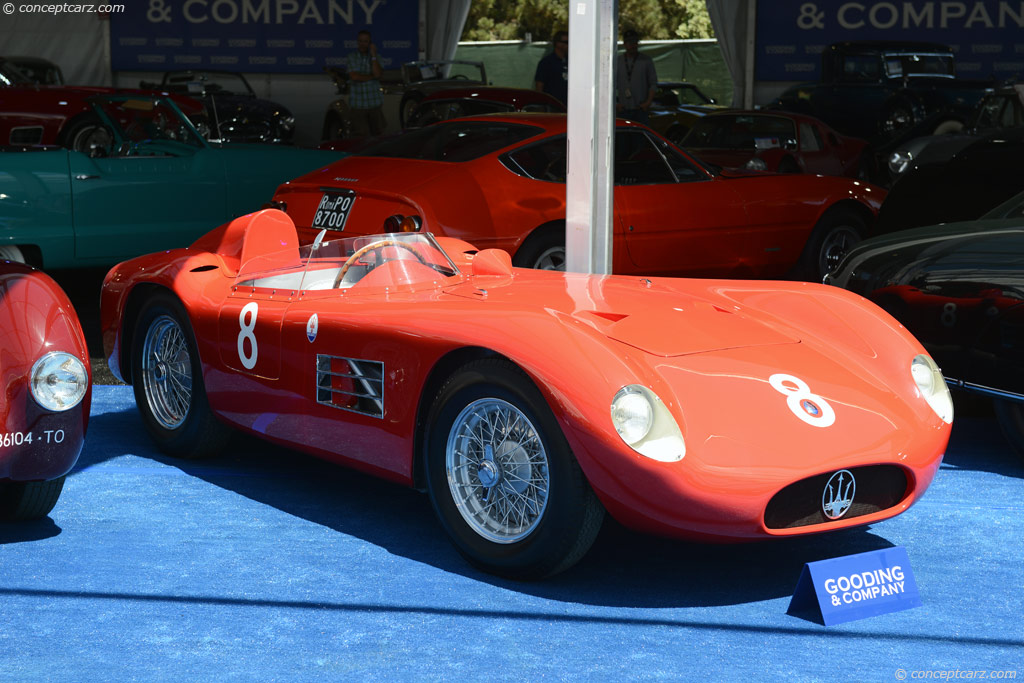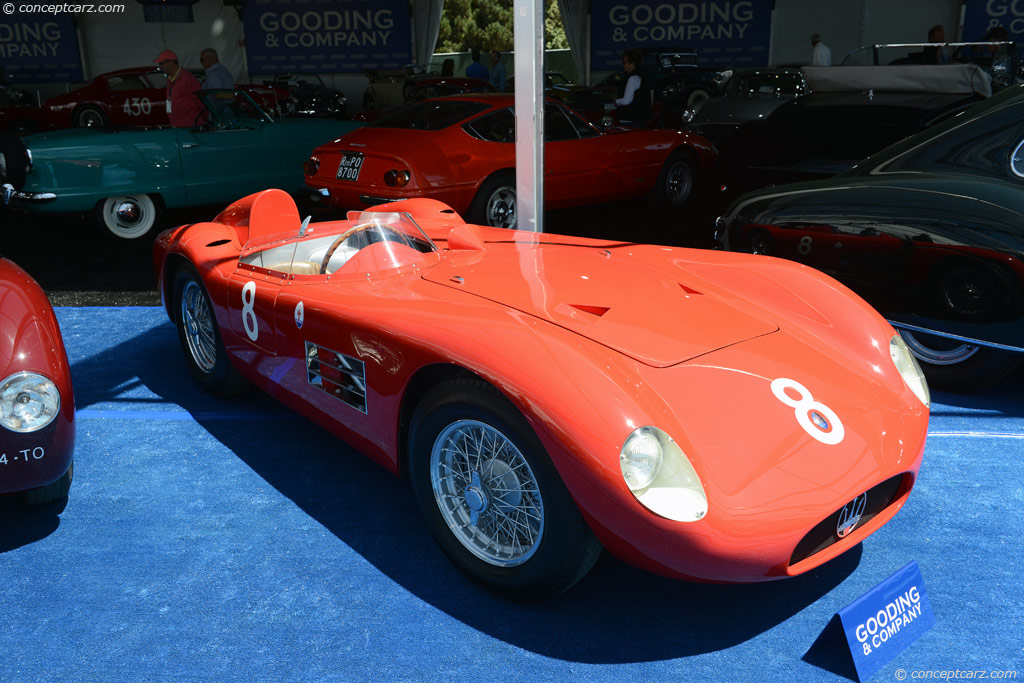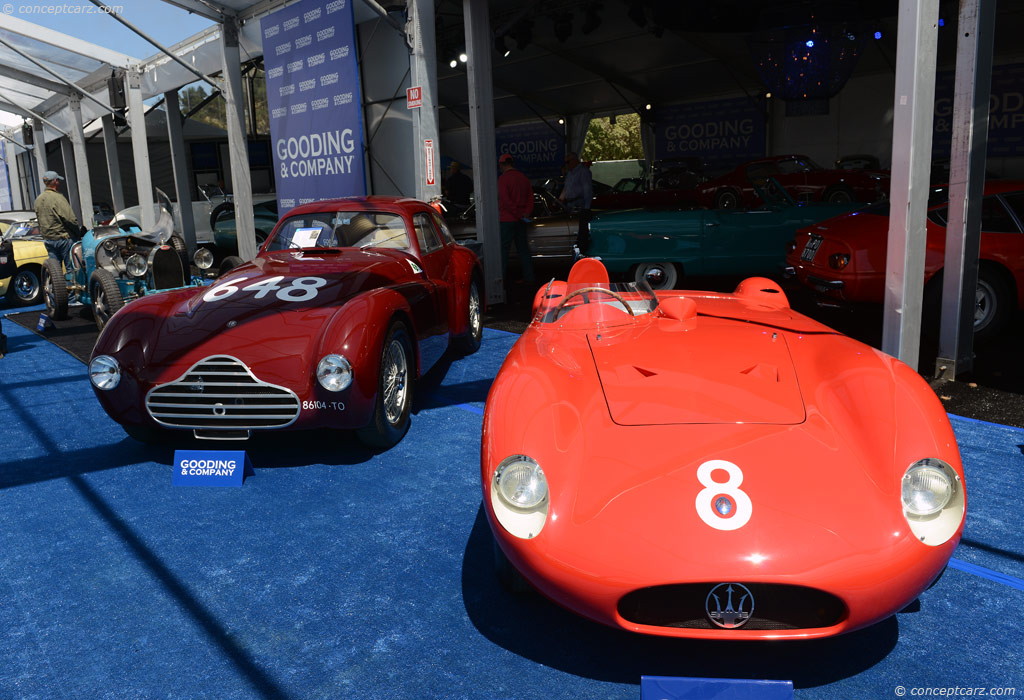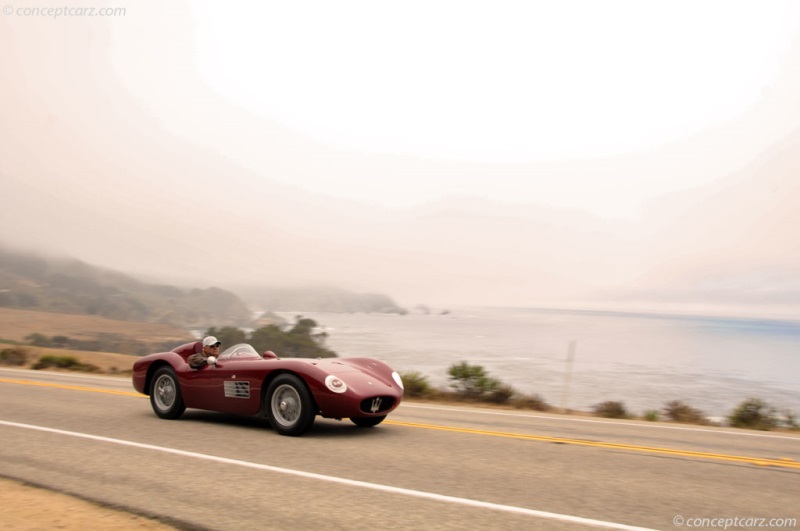Image credit: © conceptcarz.com (Reproduction Or reuse prohibited).
Throughout its history, Maserati had always built serious sportscars and single-seaters to compete in the highest levels of motorsport. However, in the mid-1950s, in an effort to draw a larger customer base to help offset costs, Maserati would look to the ultra-competitive 1.1-1.5-liter category in sportscar racing. Creating their 150S, Maserati would have an attractive sportscar for the amateur racer.
Development of the new sportscar would begin in 1953. A scaled-down version of the larger sportscars developed during the same time, the requirements for the 150S would be relatively simple as it needed to be simple as possible for its amateur customers. The main couple of things the car needed were good handling and a strong engine.
Vittorio Bellentani would develop the engine. Made of aluminum, the four-cylinder engine would actually be quite advanced using all the latest technology of the period. This included gear-driven twin overhead cams, hemispherical combustion chambers, twin-plug ignition and even dry-sump lubrication. Turning at 7,500rpm, the 1.5-liter engine was capable of producing 130bhp.
The chassis would be a tube-frame chassis Valerio Colotti would develop. The result of his work would be a chassis that would be lighter and stronger than any previous Maserati of similar size. The car would also make use of double wishbone suspension, drum brakes and a de Dion rear end.
The bodywork would be an elegant design that not only looked good but that was also quite aerodynamic. An amateur would feel as though he had signed for the factory team when he climbed behind the wheel with the beautiful Fiandri and Fantuzzi bodywork enveloping the chassis.
The Maserati 150S would immediately prove itself in competition when the factory entered one of its 27 examples in the 1955 Nurburgring 500 Kilometers. Driven by Jean Behra, the 150S would go on to break the existing lap record, but the time would not be by mere tenths. No, Behra would break the lap record by an impressive nine seconds. One year later, a 150S would go on to earn a 9th place overall finish at the 24 Hours of Le Mans.
A total of 27 examples built, chassis 1667 would be ordered by a Dutch privateer racer by the name of Lex Beels. Beels had experience racing in Formula 3. However, he would make a trip to Modena and would take to the wheel of a 150S at the Modena aerodrome circuit. Impressed by the car, Beels would place an order for one and would take delivery in May of 1956. Being a late-production example, the Beels' 150S would have Fiandri bodywork and a five-speed gearbox and Cibie headlights.
Beels would debut his new Maserati at the Zandvoort Whit Monday race on the 21st of May. In that opening race, Beels' 150S would come away with a 3rd place result in the 1.5-liter class. The great start would be interrupted a week later when 1667 ended up being disqualified at the ADAC Nurburgring 1000 Kilometers.
In August of '56, Beels would bring his 150S back to the factory where he would negotiate some updates. Unfortunately, these updates would not translate into mechanical immunity. In fact, Beels would suffer the exact opposite. Beels would again return the car to the factory for more updates and to make the car comply with the latest regulations. The work would be done but the bill would not be paid. Therefore, 1667 would just sit in storage at the factoy. In 1959, the car would be moved out of the factory for space reasons and would end up the property of Piet Peeperkorn. Peeperkorn would own the car starting in 1963 and would actually race the Maserati for a short period of time.
Chassis 1667 would end up being lost for a period of time until Rob de la Rive Box discovered the 150S in a laundromat in Heemstede. Found with its engine disassembled, it appeared the car was to be used for parts. Italian collectors would purchase the car and would keep the car in much the same condition throughout the 1980s and early 1990s.
In the late 1990s, the 150S would be restored by Carrozzeria Ferrari Jeris Srl. The car would then be sold to Maserati collector Clive Smith. With mechanical preparation completed by Hall & Hall, Smith would enter 1667 in a number of historic races, including the Mille Miglia and the historic races at Phillips Island.
When acquired by its latest owner the 150S would be exposed to a cosmetic and mechanical restoration completed by Brazell Engineering Limited in the United Kingdom. The car would be stripped right down to its metal. The car would be surprisingly original inside and out, and this would include a matching-number engine and Fiandri coachwork.
The work performed by the factory in 1959, and the work done in the years following, would cause the bodywork to have a completely different profile from the original. This would be changed during the restoration and the bodywork would be re-profiled to original dimensions. The bodywork would then be finished in correct 1956 colors and with a couple of other additions that would make is more useful as a two-seater.
Nonetheless, the condition of 1667 would make it very rare amongst the very few 150S produced by the factory. While most have suffered damage, neglect or modifications, 1667 has remained relatively untouched and undamaged over the course of its history making it very desirable.
But the car itself wouldn't be the only original feature. In addition to the car, the current owner has a large number of original documents, racing records and other records that all attest to the 150S and 1667's place in Maserati's history.
Eligible for such historic events as the Le Mans Classic and Colorado Grand, 1667 remains one of the very few 150S still able to be seen in its element. Offered at the 2013 Gooding & Company Pebble Beach auction estimates for chassis 1667 would range from between $2,250,000 and $3,000,000. Unfortunately, the bidding would fail to meet expectations. Stirling Moss would criticize the car as being 'gutless'. Unfortunately, it would seem as though this critique would be in the back of everybody's minds.
Sources:
'Lot No. 136: 1956 Maserati 150S', (http://www.goodingco.com/vehicle/1956-maserati-150-s/). Gooding & Company. http://www.goodingco.com/vehicle/1956-maserati-150-s/. Retrieved 28 August 2013.
'1957 Maserati 150S News, Pictures and Information', (http://www.conceptcarz.com/vehicle/z15218/Maserati-150-S.aspx). Conceptcarz.com: From Concept to Production. http://www.conceptcarz.com/vehicle/z15218/Maserati-150-S.aspx. Retrieved 28 August 2013.
'1955-1957 Maserati 150S Barchetta', (http://www.supercars.net/cars/1044.html). Supercars.net. http://www.supercars.net/cars/1044.html. Retrieved 28 August 2013.
By Jeremy McMullen
Development of the new sportscar would begin in 1953. A scaled-down version of the larger sportscars developed during the same time, the requirements for the 150S would be relatively simple as it needed to be simple as possible for its amateur customers. The main couple of things the car needed were good handling and a strong engine.
Vittorio Bellentani would develop the engine. Made of aluminum, the four-cylinder engine would actually be quite advanced using all the latest technology of the period. This included gear-driven twin overhead cams, hemispherical combustion chambers, twin-plug ignition and even dry-sump lubrication. Turning at 7,500rpm, the 1.5-liter engine was capable of producing 130bhp.
The chassis would be a tube-frame chassis Valerio Colotti would develop. The result of his work would be a chassis that would be lighter and stronger than any previous Maserati of similar size. The car would also make use of double wishbone suspension, drum brakes and a de Dion rear end.
The bodywork would be an elegant design that not only looked good but that was also quite aerodynamic. An amateur would feel as though he had signed for the factory team when he climbed behind the wheel with the beautiful Fiandri and Fantuzzi bodywork enveloping the chassis.
The Maserati 150S would immediately prove itself in competition when the factory entered one of its 27 examples in the 1955 Nurburgring 500 Kilometers. Driven by Jean Behra, the 150S would go on to break the existing lap record, but the time would not be by mere tenths. No, Behra would break the lap record by an impressive nine seconds. One year later, a 150S would go on to earn a 9th place overall finish at the 24 Hours of Le Mans.
A total of 27 examples built, chassis 1667 would be ordered by a Dutch privateer racer by the name of Lex Beels. Beels had experience racing in Formula 3. However, he would make a trip to Modena and would take to the wheel of a 150S at the Modena aerodrome circuit. Impressed by the car, Beels would place an order for one and would take delivery in May of 1956. Being a late-production example, the Beels' 150S would have Fiandri bodywork and a five-speed gearbox and Cibie headlights.
Beels would debut his new Maserati at the Zandvoort Whit Monday race on the 21st of May. In that opening race, Beels' 150S would come away with a 3rd place result in the 1.5-liter class. The great start would be interrupted a week later when 1667 ended up being disqualified at the ADAC Nurburgring 1000 Kilometers.
In August of '56, Beels would bring his 150S back to the factory where he would negotiate some updates. Unfortunately, these updates would not translate into mechanical immunity. In fact, Beels would suffer the exact opposite. Beels would again return the car to the factory for more updates and to make the car comply with the latest regulations. The work would be done but the bill would not be paid. Therefore, 1667 would just sit in storage at the factoy. In 1959, the car would be moved out of the factory for space reasons and would end up the property of Piet Peeperkorn. Peeperkorn would own the car starting in 1963 and would actually race the Maserati for a short period of time.
Chassis 1667 would end up being lost for a period of time until Rob de la Rive Box discovered the 150S in a laundromat in Heemstede. Found with its engine disassembled, it appeared the car was to be used for parts. Italian collectors would purchase the car and would keep the car in much the same condition throughout the 1980s and early 1990s.
In the late 1990s, the 150S would be restored by Carrozzeria Ferrari Jeris Srl. The car would then be sold to Maserati collector Clive Smith. With mechanical preparation completed by Hall & Hall, Smith would enter 1667 in a number of historic races, including the Mille Miglia and the historic races at Phillips Island.
When acquired by its latest owner the 150S would be exposed to a cosmetic and mechanical restoration completed by Brazell Engineering Limited in the United Kingdom. The car would be stripped right down to its metal. The car would be surprisingly original inside and out, and this would include a matching-number engine and Fiandri coachwork.
The work performed by the factory in 1959, and the work done in the years following, would cause the bodywork to have a completely different profile from the original. This would be changed during the restoration and the bodywork would be re-profiled to original dimensions. The bodywork would then be finished in correct 1956 colors and with a couple of other additions that would make is more useful as a two-seater.
Nonetheless, the condition of 1667 would make it very rare amongst the very few 150S produced by the factory. While most have suffered damage, neglect or modifications, 1667 has remained relatively untouched and undamaged over the course of its history making it very desirable.
But the car itself wouldn't be the only original feature. In addition to the car, the current owner has a large number of original documents, racing records and other records that all attest to the 150S and 1667's place in Maserati's history.
Eligible for such historic events as the Le Mans Classic and Colorado Grand, 1667 remains one of the very few 150S still able to be seen in its element. Offered at the 2013 Gooding & Company Pebble Beach auction estimates for chassis 1667 would range from between $2,250,000 and $3,000,000. Unfortunately, the bidding would fail to meet expectations. Stirling Moss would criticize the car as being 'gutless'. Unfortunately, it would seem as though this critique would be in the back of everybody's minds.
Sources:
'Lot No. 136: 1956 Maserati 150S', (http://www.goodingco.com/vehicle/1956-maserati-150-s/). Gooding & Company. http://www.goodingco.com/vehicle/1956-maserati-150-s/. Retrieved 28 August 2013.
'1957 Maserati 150S News, Pictures and Information', (http://www.conceptcarz.com/vehicle/z15218/Maserati-150-S.aspx). Conceptcarz.com: From Concept to Production. http://www.conceptcarz.com/vehicle/z15218/Maserati-150-S.aspx. Retrieved 28 August 2013.
'1955-1957 Maserati 150S Barchetta', (http://www.supercars.net/cars/1044.html). Supercars.net. http://www.supercars.net/cars/1044.html. Retrieved 28 August 2013.
By Jeremy McMullen
2013 Gooding and Company - Pebble Beach
Pre-Auction Estimates :
USD $2,250,000-USD $3,000,000
Lot was not sold
Recent Sales of the Maserati 150 S
(Data based on Model Year 1956 sales)
Maserati 150 Ss That Failed To Sell At Auction
1956 Maserati 150 S's that have appeared at auction but did not sell.
| Vehicle | Chassis | Event | High Bid | Est. Low | Est. High |
|---|---|---|---|---|---|
| 1956 Maserati 150S | 1667 | 2013 Gooding and Company Pebble Beach | $2,250,000 | $3,000,000 |
Vehicles With Comparable Market Values
Similar sales to the range.
1956 Maserati 150 S
• Additional valuation insight and sales data• History
• Specifications
• Image gallery
• Other Maserati 150 S model years







